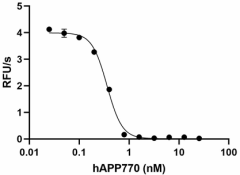- Regulatory Status
- RUO
- Other Names
- Nexin-2, ABETA, sAPPβ ,PreA4, APPI, CVAP, AD1, Amyloid Beta (A4) Precursor Protein, Alzheimer Disease Amyloid Protein

-

Recombinant human APP770 inhibits trypsin protease activity in a dose-dependent manner. The ED50 for this effect is 0.16 – 0.8 nM in the presence of 0.02 µg/mL trypsin. -

Stability Testing for Recombinant Human APP770. Recombinant human APP770 was aliquoted in PBS, pH 7 at 0.2 mg/mL and one aliquot was kept at 4°C (Control), and another was frozen and thawed four times (4x Freeze/Thaw). After this procedure, the samples were tested for their ability to inhibit trypsin protease activity. The ED50 for this effect is 0.16 – 0.8 nM in the presence of 0.02 µg/mL trypsin.
| Cat # | Size | Price | Quantity Check Availability | ||
|---|---|---|---|---|---|
| 787604 | 25 µg | $176.00 | |||
| 787606 | 100 µg | $440.00 | |||
Select size of product is eligible for a 40% discount! Promotion valid until December 31, 2024. Exclusions apply. To view full promotion terms and conditions or to contact your local BioLegend representative to receive a quote, visit our webpage.
Amyloid precursor protein (APP) is a cell surface receptor and transmembrane precursor protein expressed in neuronal cells. On the neuron surface, it is involved in a neurite growth, adhesion, and axonogenesis (1). It also participates in transcriptional regulation through protein-protein interactions. While the APP695 isoform is predominantly expressed in neurons, the APP751 and APP770 are found in non-neuronal cells. APP751 and APP770 both contain a Kunitz serine protease inhibitor domain and show identity to protease nexin-II (2). APP can be cleaved by α-, β-, and γ- secretases to generate soluble peptides with a host of different characteristics, including antimicrobial properties (3). The peptides formed from β- and γ- secretase cleavage consist of soluble APP beta and β-amyloid, which is the major component of plaque in Alzheimer’s disease. The soluble beta form of APP has been identified as a ligand for death receptor 6 (4). Soluble APP770 has been considered as a biomarker candidate of acute coronary syndrome. Plasma levels of sAPP770 are high in coronary arteria disease and these levels correlate with soluble form of CD40L a biomarker for platelet activation.
Product Details
- Source
- Human APP770 (soluble beta form), amino acid (Leu18 - Met671) (Accession: P05067), with an N-terminal 9His tag, was expressed in 293E cells.
- Molecular Mass
- The 695 amino acid recombinant protein has a predicted molecular mass of approximately 78.4 kD. The protein migrates at approximately 80 - 90 kD by SDS-PAGE in both DTT-reduced and non-reduced conditions. The predicted N-terminal amino acid is His.
- Purity
- > 95%, as determined by Coomassie stained SDS-PAGE
- Formulation
- 0.22 µm filtered protein solution is in pH 7.2, PBS.
- Endotoxin Level
- Less than 0.1 EU per µg cytokine as determined by the LAL method
- Concentration
- 25 µg size is bottled at 200 µg/mL. 100 µg size and larger sizes are lot-specific and bottled at the concentration indicated on the vial. To obtain lot-specific concentration and expiration, please enter the lot number in our Certificate of Analysis online tool.
- Storage & Handling
- Unopened vial can be stored between 2°C and 8°C for up to 2 weeks at -20°C for up to six months, or at -70°C or colder until the expiration date. For maximum results, quick spin vial prior to opening. The protein can be aliquoted and stored at -20°C or colder. Stock solutions can also be prepared at 50 - 100 µg/mL in appropriate sterile buffer, carrier protein such as 0.2 - 1% BSA or HSA can be added when preparing the stock solution. Aliquots can be stored between 2ᵒC and 8°C for up to one week and stored at -20°C or colder for up to 3 months. Avoid repeated freeze/thaw cycles.
- Activity
- Human APP770 activity is measured by its ability to inhibit trypsin enzyme activity. The ED50 of inhibition is 0.16 – 0.8 nM.
- Application
-
Bioassay
- Application Notes
-
BioLegend carrier-free recombinant proteins provided in liquid format are shipped on blue-ice. Our comparison testing data indicates that when handled and stored as recommended, the liquid format has equal or better stability and shelf-life compared to commercially available lyophilized proteins after reconstitution. Our liquid proteins are validated in-house to maintain activity after shipping on blue ice and are backed by our 100% satisfaction guarantee. If you have any concerns, contact us at tech@biolegend.com.
Antigen Details
- Structure
- Monomer
- Distribution
-
Vascular endothelial cells, brain endothelial cells, activated platelets
- Function
- Apoptotic signals, inflammatory cytokines enhance soluble APP770 secretion from endothelial cells.
- Interaction
- Caspase-3, DR6, matriptase interacts with APP770, APP751, and APP695
- Ligand/Receptor
- APP770 interacts with the low-density lipoprotein receptor-related protein (LRP)
- Bioactivity
- Inhibition of trypsin proteolytic activity
- Cell Type
- Endothelial cells, Platelets
- Biology Area
- Cardiovascular Biology, Cell Biology
- Molecular Family
- APP/β-Amyloid, APP/Aβ Degradation, Enzymes and Regulators
- Antigen References
-
- d’Uscio LV, He T, Katusic ZS, 2017. Physiology. 32:20.
- Van Nostrand WE, et al, 1989. Nature. 341:546.
- Haass C, 2004. EMBO J. 23:483.
- Nikolaev A, et al., 2009. Nature. 457:981.
- Kinoshita A, et al, 2001. J Neurosci. 21:8354.
- Kitazume S, et al. 2012. J Biol Chem. 287:40817.
- Lanchec E, et al. J Biol Chem. 292:20669.
- Miura S, et al. 2020. J Biol Chem. 295:13194.
- Gene ID
- 351 View all products for this Gene ID
- UniProt
- View information about APP770 on UniProt.org
